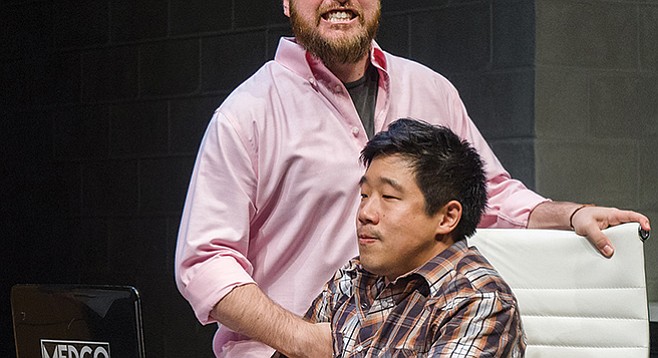 Facebook
Facebook
 X
X
 Instagram
Instagram
 TikTok
TikTok
 Youtube
Youtube

Mike Lew’s Tiger Style! is a kind of 21st-century bildungsroman for sibling protagonists, Jennifer (Jackie Chung) and Albert Chen (Raymond J. Lee), and it tells its story largely by holding popular stereotypes up to the harsh light of nuance. While stereotypical views of Chinese-American life and culture dominate the story, Lew’s script employs some other, milder stereotypes for comic effect: the douchey, Orange County programmer, embodying the Peter Principle as he freeloads his way upwards; the corporate middleman whose diction consists of 95 percent jargon and 5 percent delusional faith in post-race business culture; the “I’m okay, you’re okay” therapist, bedecked in flowy dress and dangling pendants; and the self-important CBP officer, wresting every ounce of power from his position of mild authority, and relishing every second.
Lew’s caricatures may not have their roots firmly in reality, but they certainly evoke something truthy. Though they lack the characteristic depth of a real person, these stereotypical representations have an instant familiarity that less comical characters simply can’t match.
Numerous scholars and social scientists have suggested that, on a cognitive level, the socially unacceptable stereotypes we hold about groups of people share a common form with other, much more banal concepts in human cognition. As far as the human brain is concerned, there exists no substantive difference between, on the one hand, a vague notion of Asian-Americans as good students; and, on the other, a preconception that it’s safe to leave your umbrella at home on a sunny day. These generalized categories of people and things give us an efficient conceptual framework around which we construct our understanding of the world.
Think of it another way: understanding what pants are and how they work makes getting dressed in the morning infinitely easier than if you had to approach every pair of slacks as if it were your first.
Painting the world in the broadest possible strokes is in some way endemic to how we think, which is why comical, stereotypical characters catch our attention and make us laugh — and there’s nothing inherently wrong with that. Distinguishing the subtleties of reality is another thing entirely. Still, you’re not a bad person if you laugh at Reggie the Bonnaroo Dipshit (Nate Miller, wearing some godawful Toms), or the endless Asian jokes in Tiger Style!


Mike Lew’s Tiger Style! is a kind of 21st-century bildungsroman for sibling protagonists, Jennifer (Jackie Chung) and Albert Chen (Raymond J. Lee), and it tells its story largely by holding popular stereotypes up to the harsh light of nuance. While stereotypical views of Chinese-American life and culture dominate the story, Lew’s script employs some other, milder stereotypes for comic effect: the douchey, Orange County programmer, embodying the Peter Principle as he freeloads his way upwards; the corporate middleman whose diction consists of 95 percent jargon and 5 percent delusional faith in post-race business culture; the “I’m okay, you’re okay” therapist, bedecked in flowy dress and dangling pendants; and the self-important CBP officer, wresting every ounce of power from his position of mild authority, and relishing every second.
Lew’s caricatures may not have their roots firmly in reality, but they certainly evoke something truthy. Though they lack the characteristic depth of a real person, these stereotypical representations have an instant familiarity that less comical characters simply can’t match.
Numerous scholars and social scientists have suggested that, on a cognitive level, the socially unacceptable stereotypes we hold about groups of people share a common form with other, much more banal concepts in human cognition. As far as the human brain is concerned, there exists no substantive difference between, on the one hand, a vague notion of Asian-Americans as good students; and, on the other, a preconception that it’s safe to leave your umbrella at home on a sunny day. These generalized categories of people and things give us an efficient conceptual framework around which we construct our understanding of the world.
Think of it another way: understanding what pants are and how they work makes getting dressed in the morning infinitely easier than if you had to approach every pair of slacks as if it were your first.
Painting the world in the broadest possible strokes is in some way endemic to how we think, which is why comical, stereotypical characters catch our attention and make us laugh — and there’s nothing inherently wrong with that. Distinguishing the subtleties of reality is another thing entirely. Still, you’re not a bad person if you laugh at Reggie the Bonnaroo Dipshit (Nate Miller, wearing some godawful Toms), or the endless Asian jokes in Tiger Style!
Comments